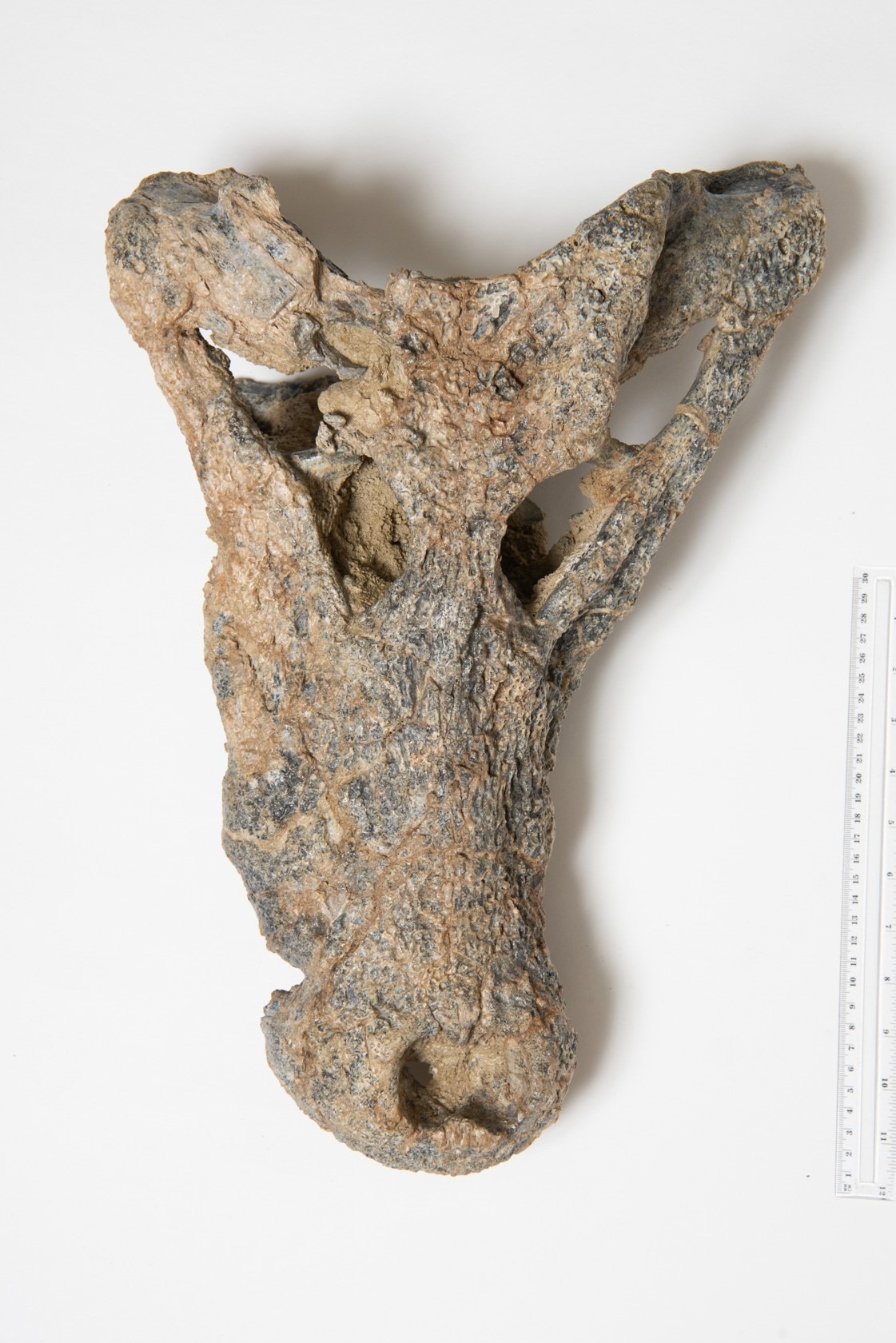A fearsome fossil crocodile that once inhabited Central Australia around 8 million years ago has finally been bestowed with a scientific name.

Image Credit: MAGNT
The species, now known as Baru iylwenpeny (pronounced Bah-roo eel-OON-bin-yah), was studied by a team led by Dr Adam Yates, the Senior Curator for Earth Sciences at the Museum and Art Gallery of the Northern Territory (MAGNT).
A paper titled ‘The last Baru (Crocodylia, Mekosuchinae): a new species of ‘cleaver-headed crocodile’ from Central Australia and the turnover of crocodylians during the late Miocene in Australia, appears in Papers in Palaeontology, a journal published by the Palaeontological Association.
Fossils of Baru iylwenpeny come from the Alcoota Scientific Reserve, 110 kilometres northwest of Alice Springs in the Northern Territory. The reserve sits within the Traditional lands of the Alyawarr- and Anmatyerr-speaking peoples and is surround by the Alkwert Aboriginal Land Trust.
The first fragments of Baru iylwenpeny were unearthed during the inaugural scientific excavations at Alcoota in the early 1960s by Michael Woodburne, a then, PhD student from the University of California. These early discoveries were fragmentary, modest and failed to fully reveal the distinctiveness of the large crocodile species that once inhabited Alcoota during the Miocene. These fossils were initially categorized as tentatively belonging to the Crocodylus genus, which encompasses the living Australian freshwater and saltwater crocodiles, before fading into obscurity.
The pivotal breakthrough came in 2009, when Jared Archibald, MAGNT Curator of Territory History and long-term Alcoota excavator was working on the site. He unearthed a complete skull which now is the holotype (name-bearing specimen) for the newly identified species. Over the subsequent decade, painstaking efforts were invested in the thorough cleaning of the skull, followed by meticulous study and comparisons with other fossil crocodylians. This culminated in the production of a monograph that describes and names the new species.
The name 'iylwenpeny’ comes from the Anmatyerr language spoken in the Alcoota region and encapsulates the likely prowess of this extraordinary creature as a proficient hunter.
With the unveiling of Baru iylwenpeny, a remarkable new chapter in Australia's prehistoric history is written, forever etching this magnificent crocodile into the chronicles of western scientific discovery.
A reconstructed skeleton of Baru iylwenpeny is on display at Megafauna Central, 21 Todd Street, Alice Springs, Northern Territory.
Quotes from Dr Adam Yates, Senior Curator for Earth Sciences, Megafauna Central MAGNT
"The unveiling of Baru iylwenpeny marks a milestone in our understanding of Australia's prehistoric fauna.
"The first bones of Baru iylwenpeny surfaced during the inaugural scientific excavations at Alcoota in the early 1960s by Michael Woodburne, providing us with tantalising glimpses of its existence. However, it wasn't until our recent dedicated efforts that we truly grasped its distinctiveness.
"The moment we found the complete skull was truly exhilarating. It was like uncovering a missing puzzle piece that allowed us to finally understand the entirety of Baru iylwenpeny's morphology and significance.
"The name 'iylwenpeny' derived from the Anmatyerr language spoken in the Alcoota region, embodies the likely prowess of this remarkable creature as a skilled hunter. Baru iylwenpeny has finally taken its rightful place in the story of Australia's ancient past, providing us with insights into a world that existed millions of years before us.”
Australia was home to a remarkably diverse group of crocodylians called mekosuchines, of which the newly described species Baru iylwenpeny is a part of. Although all mekosuchines are now extinct, their fossil remains are a testament to their abundance and importance in Australian ecosystems for tens of millions of years. Some mekosuchines, such as Baru iylwenpeny, were the top predators in their respective environments.”
Dr Jorgo Ristevski Honorary, Fellow at The University of Queensland, Co-Author on the New Study
Quotes from Associate Professor Steve Salisbury, School of the Environment, The University of Queensland and co-author on the new study
“Species of Baru probably represent some of the most fearsome predators to have inhabited Australia over the last 10 million years. Baru iylwenpeny is the geologically youngest of the three species that are known, the others being Baru darrowi and Baru wickeni. It’s also the best-represented, with multiple skulls from juveniles through to fully mature adults having been recovered. We pretty much know exactly what it looked like.
“Imagine a 4–5 metre long Indo-Pacific crocodile, but with a shorter, deeper snout and very large, backward pointing teeth, and a generally heavier, gnarly-looking head. That’s Baru! It’s no wonder they’ve become known as ‘cleaver-headed’ crocodiles.
“It’s terrifying to think that animals such as Baru iylwenpeny once inhabited the water courses of Central Australia. Their disappearance around 8 million years ago heralds the start of a period of global cooling, coinciding with an intense pulse of drying of the Australian interior. Ultimately, this drying led to the disappearance of many of the waterways that these crocodiles once inhabited. A new crocodylian fauna would emerge millions of years later in what is now the Kati Thanda–Lake Eyre basin. A similar turnover of crocodylian diversity is seen in Africa and South America, possibly in response to similar events there.”